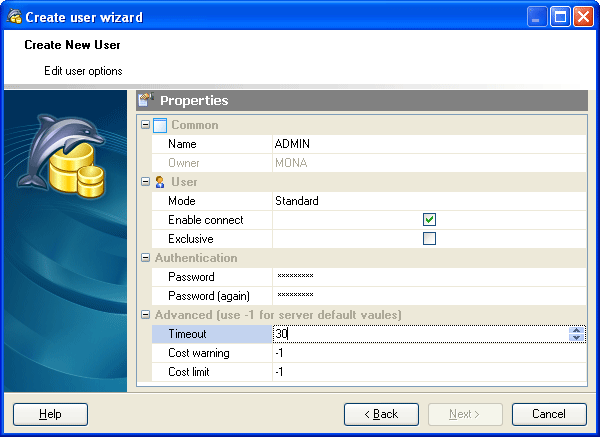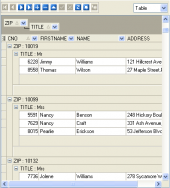MaxDB Maestro online Help
| Prev | Return to chapter overview | Next |
Specifying user option
Specify user options according to your needs. The detailed description is given below.

Name
The field contains the editable new user name as it was set on the previous wizard step.
Owner
Displays the user owner (The user owner is his creator).By default, only the owner of an object can perform various operations with the object. In order to allow other users to operate it, privileges must be granted. (However, users that have the superuser attribute can always access any object.)
User Mode
The user mode distinguish the authorization that the user will have.
STANDARD - Access to data and database procedures that were defined by other database users and for which the user has been given privileges. Definition of view tables, synonyms and temporary tables
RESOURCE - Definition of data and database procedures. Granting of privileges for these database objects to other database users
DBA (database administrator) - Creation of RESOURCE and STANDARD database users
Definition of database objects. Granting of all or part of privileges for these database objects to other database users
Enable connect
You use the option to define whether a user can open database sessions.
Exclusive
Check the option to prevent the user from opening several different database sessions simultaneously.
Password
Use the field to define the password for the user been creating. The password must be specified when a database session is started. It ensures that only authorized users can access the database system.
Timeout
The timeout value determines the maximum duration of inactivity in a database session. The duration of inactivity is the time interval between ending an SQL statement and sending the next SQL statement. As soon as the timeout value is exceeded, the database system ends the database session with a ROLLBACK. The value is specified in seconds and must be between 30 and 32400.
Cost warning
Use the field to specify the estimated SELECT cost value beyond which the user receives A warning. In this case, the user is asked whether he or she really wants to execute the SQL statement. The Cost limit value must be less than the Cost warning value.
Cost limit
Enter here the estimated SELECT cost value beyond which the SQL statement is not executed.
The Cost limit value must be greater than the Cost warning value.
| Prev | Return to chapter overview | Next |




 Download
Download Buy
Buy
